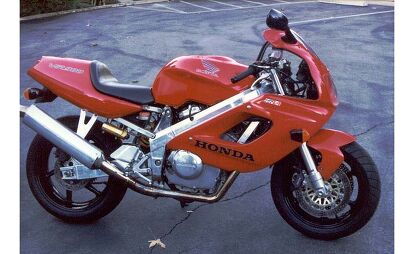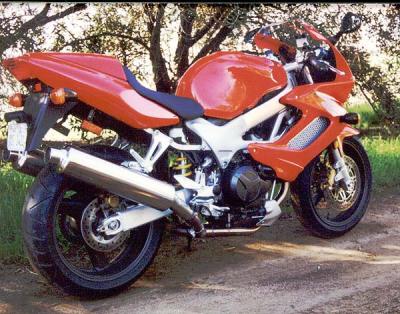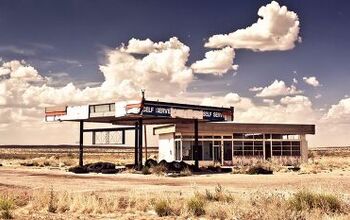Church Of MO: Honda VTR1000F Super Hawk

Remember when Honda built a 1000cc V-Twin and put it in something sporty to go against Ducati and the 916? Then do you remember how Honda only half-committed to building a Ducati beater and the bike really wasn’t a match for the 916 at all? If you do, then you remember the VTR1000F Super Hawk, also lovingly known as the Super Chicken. Before Honda got serious and built the RC51 (or the RVT1000R or VTR1000 SP1 in other parts of the world), it built this.
The Super Hawk had some similarities with the RC, like the V-Twin engine and side-mount radiators, but when it came to the performance metrics that really matter, the Super Hawk was no match for its Italian rival. Still, for those folks who like the thought of a more comfortable RC51-esque Honda V-Twin from the late 90s, the Super Hawks are fun bikes that can be found for cheap these days. Here’s our review of the bike from its introduction in 1998.
Honda VTR1000F Super Hawk
Big Red Introduces Their Sporting V-Twin to America
American Honda recently threw a coming-out party for the all-new VTR1000F Super Hawk, inviting the U.S. moto-press to the bash. The event’s backdrop was the picturesque wine country of Temecula, California, and its maze of gnarly, tight, and twisting back roads proved the perfect venue to show off, as one Honda engineer put it, the Super Hawk’s “lively personality.” And lively it is, too. With the VTR, Honda feels they’ve “grabbed the essence of what Americans want in a big, sporting V-twin. The distinctive sound and feel that makes a V-twin seem alive.” A spokesman for Honda’s R&D department said their target for the Super Hawk was lightweight, light steering, and strong low- to mid-range power and torque. Sound like a certain lusty Italian bike we know?
Our first impression was that the VTR seemed easier to ride fast than a 916 but soon realized this was not a race replica. Indeed, Honda claims the Super Hawk was never intended as a racing platform. Rather, they deemed it more of a real-world, all-around sporting motorcycle like Honda’s own VFR750, but with the robust power delivery only a large displacement V-twin can provide.
Honda admitted to being caught off guard by Suzuki’s introduction of their TL1000 90-degree V-twin and was even more surprised by their rapid release of the bike to dealers. Honda quickly moved the Super Hawk’s press launch up by several weeks, and production is set to hit dealers by April.
Expected retail price of the bike should be around $8900, and Honda plans to keep production numbers low, with each dealer expected to receive only two VTR’s over the next 12 months.
According to Honda engineers, the Super Hawk’s frame went through six major redesigns. The Super Hawk’s unusual frame design contributes greatly to helping meet Honda’s original design goals of lightweight and responsive steering.
Honda engineers described the VTR’s chassis as being “lively” and fine-tuned, with six strategically-placed mounting points for an engine that also acts as a stressed member for increased rigidity and lighter weight. Centralized engine placement combines with a slightly tall caster angle to help keep front-end handling light.
The “pivotless” twin-spar frame was designed around the VTR’s OEM radial tires, which use a softer construction than that found on other sporting machines. Mounting different treads, according to Honda, will upset the “tuned” balance of the Super Hawk’s chassis.
The Super Hawk engine displaces 996cc and features almost identical, 180-degree reversed cylinders and heads. 98 x 66mm bore/stroke is identical to that of Suzuki’s new TL1000S. The six-speed gearbox is located directly below the rear cylinder.
Nutless connecting rods have bolts threaded directly into tapped holes in the rods that contribute to a lower reciprocating weight. “Rods are carburized to allow them to be slimmer and lighter while maintaining strength.” This combination results in a rod that is nearly 40 grams lighter than a conventional set-up. 48mm slanted flat-slide CV carbs are the largest ever used on a production motorcycle.
The side-mounted dual radiators of the Super Hawk produce the same cooling area as a single front-mounted radiator, but according to Honda engineers, the VTR does not have the “dead spots” you find in a radiator mounted in the traditional location behind the front forks, which can result in as much as a 20 percent loss of cooling efficiency.
The VTR’s design utilizes the low pressure created by wind passing over the outer surface of the fairing to draw air through from the high-pressure zone inside. At low speeds, a large right-side fan blows air over that radiator for cooling.
The instrumentation is clean and simple. The white-faced tach and temp gauge are very legible and easy to read even at night. Note the low fuel warning lamp in tach face – you’ll see this light up often. The cockpit is also simple and purposeful. Honda wanted to keep the Super Hawk light – very light – so you won’t find any heavy inner fairing panels or dress-up items here.
Even the clutch master cylinder reservoir receives the lighter-is-better treatment, being made from plastic rather than a heavier aluminum casting. Note spring preload and ten-position rebound damping adjusters on top of fork. Dual floating 296mm front discs are clamped by four-piston Nissin calipers similar to those used on the RC45 road bike. Coupled with engine braking from the hearty V-twin motor, stopping power is most impressive.
“VTR really shines in the broad spread of power available from its torquey motor.”
We didn’t get to spend much time with the VTR1000, but an afternoon of circling Willow Springs Raceway’s 2.5-mile road course lead us to the conclusion that Honda is correct — this is not a track-oriented design. “Honda personnel may have described this bike as having a lively personality,” said Associate Editor Gord Mounce after a short track session on the VTR. “But like a blind date with a ‘great personality,’ you don’t want to take her dancing.” Suspension rates that performed so well on the backroads were too soft for racetrack duty.
In the VTR’s defense, we didn’t have time to change springs or oil, which would have helped. A bigger hurdle for those thinking of racing VTRs is the lack of ground clearance. Rearset pegs and a tighter exhaust pipe will be necessary purchases.
Where the VTR really shines is in the broad spread of power available from its torquey motor. Speed is deceiving on Honda’s V-twin because power builds steadily with no major peaks or valleys. Such a wide powerband allows strong corner exits, with less sliding of the rear tire than on an inline four with its peaky power. Although the VTR felt slow on the straights due to this flat power curve, we found ourselves smoking by 600s on Willow’s front straight.
We certainly plan on getting the Super Hawk back for a longer, more involved test soon. Only next time we hope to also have Suzuki’s TL1000S, and maybe even a Ducati 916 thrown in for good measure (and what a yardstick to measure by…). Watch for the ultimate sporting twin-cylinder performance battle next month in Motorcycle Online. Stand back and let the competition begin!

Troy's been riding motorcycles and writing about them since 2006, getting his start at Rider Magazine. From there, he moved to Sport Rider Magazine before finally landing at Motorcycle.com in 2011. A lifelong gearhead who didn't fully immerse himself in motorcycles until his teenage years, Troy's interests have always been in technology, performance, and going fast. Naturally, racing was the perfect avenue to combine all three. Troy has been racing nearly as long as he's been riding and has competed at the AMA national level. He's also won multiple club races throughout the country, culminating in a Utah Sport Bike Association championship in 2011. He has been invited as a guest instructor for the Yamaha Champions Riding School, and when he's not out riding, he's either wrenching on bikes or watching MotoGP.
More by Troy Siahaan






























































Comments
Join the conversation